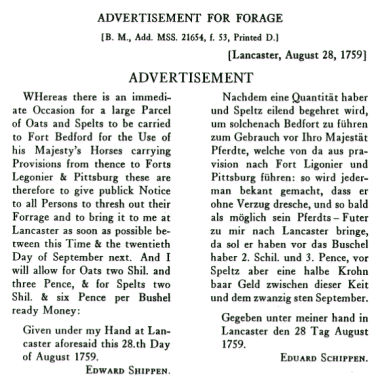|
|
Leonard
May among
Waggoners Hauling Forage
for the British in 1759
"The
Papers of Henry Bouquet - Vol. 4"
Copies
provided in 2003 by John Hanak,
a descendant in the 14th May generation.
© 2003 Fred
T. May
Records have been found regarding waggoners being hired in 1759 to haul forage at the request of Colonel Henry Bouquet for horses being used by British troops in Western Pennsylvania. Bouquet, a Swiss Soldier of Fortune, commanded part of a regiment of Royal Americans that consisted primarily of Pensylvania German recruits. This is of specific interest to May genealogists since one of the records names Leonard May as one of the waggoners who responded to an appeal in a Lancaster, Pennsylvania newspaper by Edward Shippen for "Oats and Spelts to be carried to Fort Bedford for the Use of his Majesty's Horses carrying Provisions from thence to Forts Legonier (sic Ligonier) & Pittsburg." Tax and census records in Lancaster during this period also list Leonard's occupation as "Wagner" or "Waggoner." Fort Bedford is located about 120 miles west of Lancaster and 90 miles east of Pittsburgh and Fort Ligonier is located about halfway between Fort Bedford and Pittsburgh.
Today Fort Bedford Museum is located near the site of the original fort Bedford in downtown Bedford, Pennsylvania. Fort Bedford Museum specializes in local artifacts. Old Fort Bedford was a British stockade built in 1758 as part of the French and Indian War campaign against the French at Fort Duquesne. Facing the formidable task of crossing the Allegheny Mountains and the threat of attack, numerous stockades were built along the way west. Fort Bedford was constructed as a key fortification along the military path, Forbes Road, and served as the staging area for the successful campaign. After the war Fort Bedford stood until the 1770s, used as a British outpost on the frontier and as a refuge from Indian attack as westward migration increased in the 18th century.
Fort Duquense was burned and abandoned by the French in November 1758, soon before the arrival of General Forbes with a large force of about six thousand men. Bouquet was second in command and about fifteen hundred Virginian troops were commanded by Colonels George Washington and William Byrd. Forbes took the liberty of naming the site "Pittsbourgh," in a letter to William Pitt. In very bad health, Forbes returned to Philadelphia, where he died on March 11, 1759. Soon afterwards, Bouquet established his headquarters at Fort Bedford and directed the work of moving troops and supplies. He put men to work constructing a road from Fort Ligonier to Pittsburgh and it was completed by the end of October. As soon as sufficient provisions had been forwarded, reinforcements were sent to Fort Ligonier and Pittsburgh. A fort was ordered to be built at Pittsburgh to maintain "the undisputed possession of the Ohio." Fort Pitt was ready for occupancy in March 1760 and was fully completed in the fall of 1761.
Note that the advertisement by Shippen was written in both English and German, a standard format for the bi-weekly, bilingual paper, "Lancasterishe Zeitung & Lancaster Gazette."

Shippen wrote a report to Bouquet on 15th Sep 1759 regarding the status of a recent shipment of forage amounting to 2386 bushels. He tells of some of the financial arrangements that were made for the purchase of wagonloads of various items.
